Developer Guide
- Setting up, getting started
- Design
- Implementation
- Documentation, logging, testing, configuration, dev-ops
- Appendix: Requirements
- Appendix: Instructions for manual testing
Setting up, getting started
Refer to the guide Setting up and getting started.
Design
.puml files used to create diagrams in this document can be found in the diagrams folder. Refer to the PlantUML Tutorial at se-edu/guides to learn how to create and edit diagrams.
Architecture
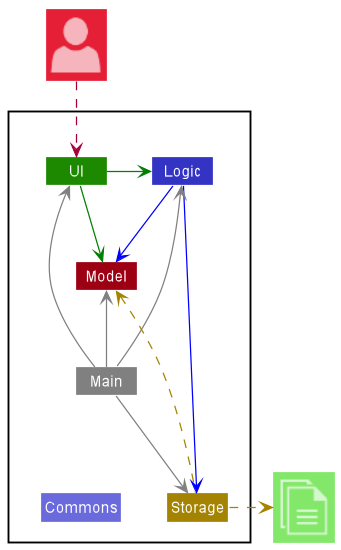
The Architecture Diagram given above explains the high-level design of the App.
Given below is a quick overview of main components and how they interact with each other.
Main components of the architecture
Main has two classes called Main and MainApp. It is responsible for,
- At app launch: Initializes the components in the correct sequence, and connects them up with each other.
- At shut down: Shuts down the components and invokes cleanup methods where necessary.
Commons represents a collection of classes used by multiple other components.
The rest of the App consists of four components.
-
UI: The UI of the App. -
Logic: The command executor. -
Model: Holds the data of the App in memory. -
Storage: Reads data from, and writes data to, the hard disk.
How the architecture components interact with each other
The Sequence Diagram below shows how the components interact with each other for the scenario where the user issues the command delete 1.
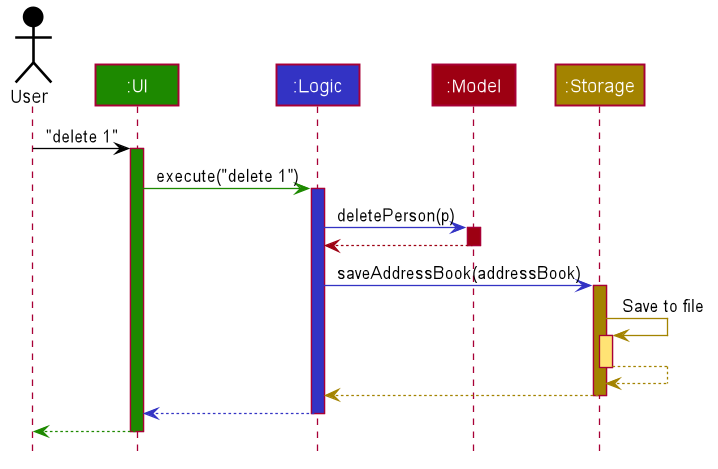
Each of the four main components (also shown in the diagram above),
- defines its API in an
interfacewith the same name as the Component. - implements its functionality using a concrete
{Component Name}Managerclass (which follows the corresponding APIinterfacementioned in the previous point.
For example, the Logic component defines its API in the Logic.java interface and implements its functionality using the LogicManager.java class which follows the Logic interface. Other components interact with a given component through its interface rather than the concrete class (reason: to prevent outside component’s being coupled to the implementation of a component), as illustrated in the (partial) class diagram below.
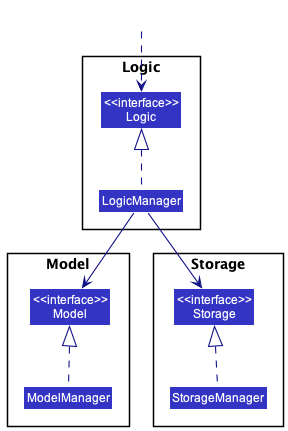
The sections below give more details of each component.
UI component
The API of this component is specified in Ui.java

The UI consists of a MainWindow that is made up of parts e.g.CommandBox, ResultDisplay, PersonListPanel, StatusBarFooter etc. All these, including the MainWindow, inherit from the abstract UiPart class which captures the commonalities between classes that represent parts of the visible GUI.
The UI component uses the JavaFx UI framework. The layout of these UI parts are defined in matching .fxml files that are in the src/main/resources/view folder. For example, the layout of the MainWindow is specified in MainWindow.fxml
The UI component,
- executes user commands using the
Logiccomponent. - listens for changes to
Modeldata so that the UI can be updated with the modified data. - keeps a reference to the
Logiccomponent, because theUIrelies on theLogicto execute commands. - depends on some classes in the
Modelcomponent, as it displaysPersonobject residing in theModel.
Logic component
API : Logic.java
Here’s a (partial) class diagram of the Logic component:

How the Logic component works:
- When
Logicis called upon to execute a command, it uses theAddressBookParserclass to parse the user command. - This results in a
Commandobject (more precisely, an object of one of its subclasses e.g.,AddCommand) which is executed by theLogicManager. - The command can communicate with the
Modelwhen it is executed (e.g. to add a person). - The result of the command execution is encapsulated as a
CommandResultobject which is returned back fromLogic.
The Sequence Diagram below illustrates the interactions within the Logic component for the execute("delete 1") API call.
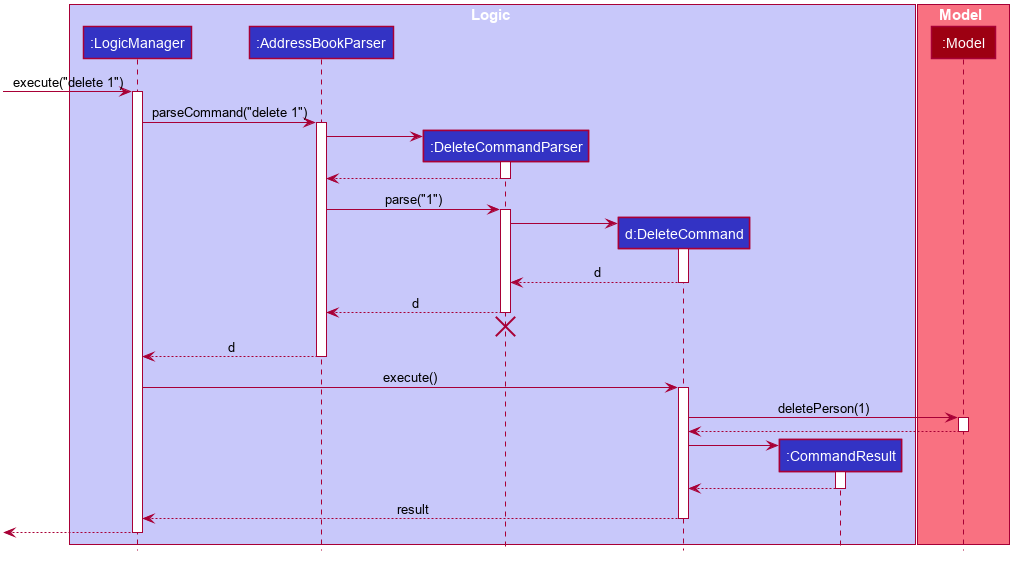
DeleteCommandParser should end at the destroy marker (X) but due to a limitation of PlantUML, the lifeline reaches the end of diagram.
Here are the other classes in Logic (omitted from the class diagram above) that are used for parsing a user command:

How the parsing works:
- When called upon to parse a user command, the
AddressBookParserclass creates anXYZCommandParser(XYZis a placeholder for the specific command name e.g.,AddCommandParser) which uses the other classes shown above to parse the user command and create aXYZCommandobject (e.g.,AddCommand) which theAddressBookParserreturns back as aCommandobject. - All
XYZCommandParserclasses (e.g.,AddCommandParser,DeleteCommandParser, …) inherit from theParserinterface so that they can be treated similarly where possible e.g, during testing.
Model component
API : Model.java
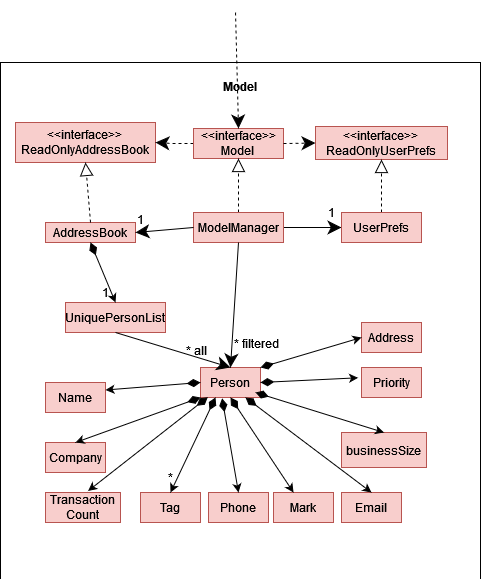
The Model component,
- stores the address book data i.e., all
Personobjects (which are contained in aUniquePersonListobject). - stores the currently ‘selected’
Personobjects (e.g., results of a search query) as a separate filtered list which is exposed to outsiders as an unmodifiableObservableList<Person>that can be ‘observed’ e.g. the UI can be bound to this list so that the UI automatically updates when the data in the list change. - stores a
UserPrefobject that represents the user’s preferences. This is exposed to the outside as aReadOnlyUserPrefobjects. - does not depend on any of the other three components (as the
Modelrepresents data entities of the domain, they should make sense on their own without depending on other components)
Tag list in the AddressBook, which Person references. This allows AddressBook to only require one Tag object per unique tag, instead of each Person needing their own Tag objects.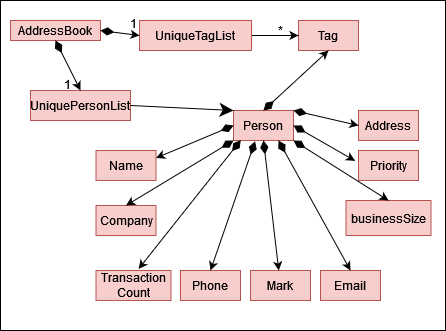
Storage component
API : Storage.java

The Storage component,
- can save both address book data and user preference data in json format, and read them back into corresponding objects.
- inherits from both
AddressBookStorageandUserPrefStorage, which means it can be treated as either one (if only the functionality of only one is needed). - depends on some classes in the
Modelcomponent (because theStoragecomponent’s job is to save/retrieve objects that belong to theModel)
Common classes
Classes used by multiple components are in the seedu.addressbook.commons package.
Implementation
This section describes some noteworthy details on how certain features are implemented.
Data Summary feature
Implementation
It extends AddressBook. Data summary includes contact count, number of tags,…
Given below is an example usage scenario and how the data summary mechanism behaves at each step.
Step 1. The user launches the application for the first time.
Step 2. The user populate the address book with commands such as add, edit, delete.
Step 3. The user click on the summary tab.
Step 4. The user now sees a summary of his/her data.
Step 5. The user then decides to close the tab, he/she clicks on the close button.
The following activity diagram summarizes what happens when a user executes a new command:
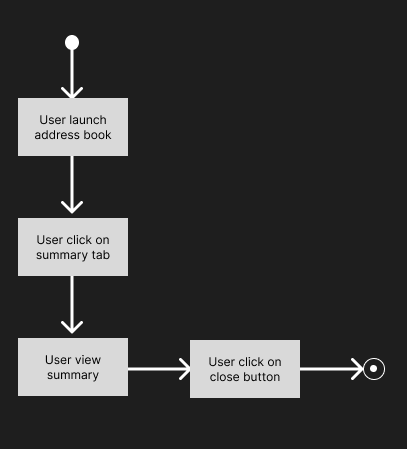
Why this implementation:
Keeping a summary in a new tab makes the UI much neater, rather than displaying a summary in the main page. This also allows user to access their summary easily as the summary tab will be fixed at the top of the page.
Design considerations:
Aspect: How data summary display executes:
-
Alternative 1 (current choice): Display in a separate tab.
- Pros: Convenience for the user.
- Cons: Slight revamp of UI is needed.
-
Alternative 2: Display in the main page.
- Pros: Ease to implement.
- Cons: Information will be cramped together.
{more aspects and alternatives to be added}
Filter by tag feature
Implementation
The proposed feature will allow users to filter persons by the tags they possess.
It is implemented similar to the FindCommand, extending CommandParser with a new command to parse.
Given below is an example usage scenario and how the Filter mechanism behaves at each step.
Step 1. User inputs command filter, followed by a list of arguments representing the tag names
example carInsurance
Step 2. The command “filter” will be parsed, creating a Filter command which is executable.
Step 3. On execution of the filter command, the filter checks and returns a list of all persons which match exactly the tags specified
Step 4. For example, filter car insurance returns a list of persons which have both car and insurance as tags, any person with only one of the two tags will not be included
The following sequence diagram shows how the filter operation works:
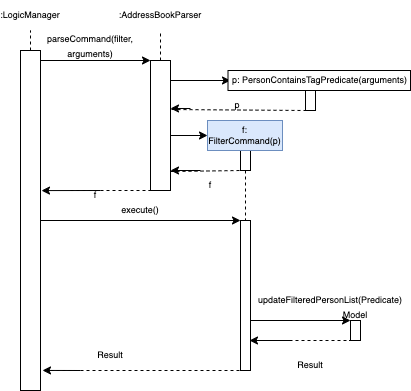
Design considerations:
- Users would like to be able to filter which category of leads they would like to view
- Users would like to be able to specify multiple tags to narrow down their search on relevant contacts
- Users would also be able to edit their clients/persons category
Aspect: How filter decides on output:
-
Alternative 1 (current choice): Only output persons which contain all tags.
- Pros: Allow user to narrow down search quicker.
- Cons: Lesser contacts are displayed to user.
-
Alternative 2: Output persons which have at least 1 of the specified tags.
- Pros: Broad search of all tags.
- Cons: Too much information, might be harder to narrow down search.
Why this implementation
We would like users to be able to narrow down search by filtering more and more categories, hence we allow multiple arguments input and require that all arguments are satisfied. Depending on customer feedback, we may change to the other alternative of a broad search, where we output all contacts that contain any of the specified tags.
Sort feature
Implementation
The proposed feature will allow users to sort their contacts in multiple ways according to fields:
- Name
name - Potential Sale Value
size - Past Transaction Count
trans - Priority
priority
The feature allows users to sort contacts according to one of the above fields at a time, in 2 directions:
- Ascending
asc - Descending
desc
Note that the sort feature updates the original contact list to be sorted accordingly.
Given below is an example usage scenario and how the Sort mechanism behaves at each step.
Step 1. User inputs command sort FIELD DIRECTION example sort size asc
Step 2. The respective sort command will be parsed, taking into account the FIELD and DIRECTION to sort by
- The sort command parser takes in the arguments and is case-insensitive
- meaning
SOrt PRIORITY DeScfor example is equivalent tosort priority desc
Step 3. After which the parser creates the respective sort command which is executable.
Step 4. On execution of the sort command, the database of contacts is sorted accordingly using the Java Collections library and the new list is displayed.
The following sequence diagram shows how the filter operation works:

Notes:
In our example, sort size asc sorts the list of contacts by ascending potential business size,
which means that contacts with smaller potential business will appear near the top.
This could prove useful for our target users - Salesmen - where they would like to focus more attention on clients who potentially bring in more business.
The sort feature allows them to quickly view their contacts by business size accordingly.
Design considerations
- Users would like to be able to sort by:
- the potential size of leads/business
- ascending order - to allow salesman to focus on improving weak leads
- descending order - to allow salesman to focus on capitalising on the best opportunities
- Name - for admin purposes
- Past transaction count
- History: Being able to keep track of transaction counts allows the salesman to see who are his most loyal or familiar clients.
- Priority
- Having specified the priority of which to take action, sorting by highest priority quickly lets the salesman see his most important clients.
- the potential size of leads/business
- Users would also be able to edit their clients/persons details
- This would be achievable with the
editfeature
- This would be achievable with the
Why this implementation
Increment/Decrement feature
Implementation
The proposed feature will allow users to increment the transaction counts of existing contacts, without the need for manual calculation. For the sake of convenience, explanation of the feature will be in terms of the increment variant. However, the decrement variant works similarly, and differences will be highlighted in the succeeding discussion.
The increment/decrement command takes in an index and an AMOUNT_TO_INCREMENTED. This AMOUNT_TO_INCREMENTED is demarcated with a prefix tr/.
The activity diagram below describes how the increment feature works.

Given below
The following sequence diagram shows how the increment operation works:
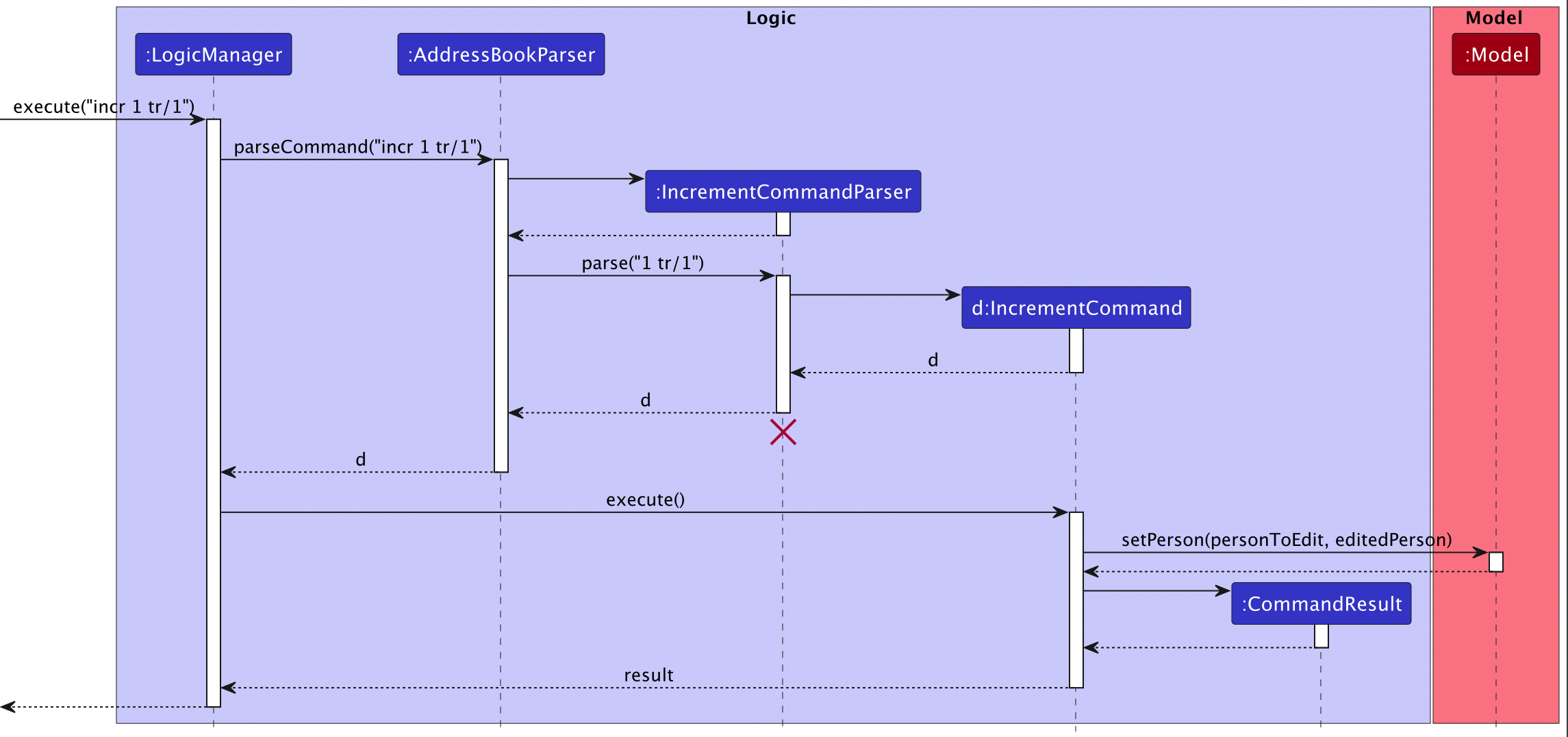
Notes: For the decrement function, the activity and sequence diagram works similarly, however, what constitues a valid amount to increment and decrement might differ. We must check in the case of decrement that fianl amount <= current and for increment final amount >= current.
Design considerations
- If users use the edit feature to modify transaction counts, which could be very large values, they are required to calculate the final values themselves, which diminishes the utility from using such an app. Therefore, the increment command was created so that user will be exempt from making such calculation errors.
- Furthermore, if users prematurely increment the transaction count, and subsequent transactions are cancelled /merged, they would require a decrement command to change the transaction count back in an error-free way.
- The syntax should be relatively similar to the edit command, since user should already be used to the prefix names. Hence, the command was designed to have minimal deviation from the edit command.
Why this implementation
A main modify transaction count was considered in the case of implementing this feature. However, because of the edit, no additional functionality to the user is provided with such an implementation. An abstract class or interface was considered for this implementation. However, for the sake of making the code more extensible in the future, it seems that implementing them as two distinct commands will work better. This is because most of the commonalities are already captured in the command class, and the edit command. Hence, letting despite the fact that letting these commands use the edit commands functions might increase coupling, it is better since the edit commands are already well tested. If new functions would be made just for these commands, they would not be as well tested and moreover contain very similar logic.
Mark/Unmark feature
Implementation
The proposed feature will allow users to mark certain contacts they have in NBF as needing follow-ups or to unmark them as no need to follow-up.
The mark/unmark command takes in an index and a YES/NO, which is demarcated with a prefix m/, which is used to inform the model to mark or to unmark the specified contact. More simply, m/yes marks that contact and m/no unmarks the contact.
The activity diagram below describes how the mark feature works.

Given below
The following sequence diagram shows how the marking operation works:
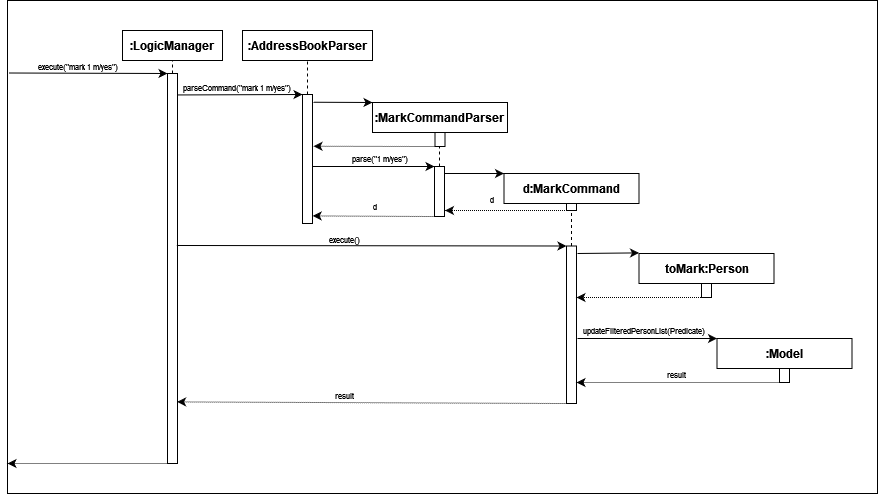
Notes:
Design considerations
- Sometimes users may forget if a contact they have in NBF is marked or unmarked, and proceed to mark or umark the contact again respectively. This may cause the contact to unmarked / marked, opposite of the user’s intention. Hence an error message is shown, informing the user that the spcified contact is already marked or unmarked, and the original marking of the specified contact does not change.
- When adding a new contact into NBF using
add, the new contact is marked as requiring follow-ups by default. This is so that the user does not get overwhelmed with all the fields that need to be filled in with theaddcommand. Furthermore, it doesn’t make sense for new contacts to not need any follow-ups in the general case. - Instead of using
unmark, themarkcommand is implemented with an addition fieldm/ YES/NOto indicate to mark or to unmark. This is to simplify the model by using 1 command to do both things.
Why this implementation
This feature adds functionality for users, as it allows the user to easily check for which contacts require following-up, by using this command in combination with the find command.
Documentation, logging, testing, configuration, dev-ops
Appendix: Requirements
Product scope
Evolve AB3 into a lightweight CRM / Contact manager for a company’s sales department.
The AB3 Evolution: NextBigFish (NBF)
is a desktop app tailored for the needs of sales-people, supporting the management of contacts, leads or clients ** and optimized for use via a Command Line Interface (CLI) while still having the benefits of a Graphical User Interface (GUI). If you can type fast, NBF can get your client and lead management tasks done faster than traditional GUI apps. NBF allows client contacts to hold data on their potential business size and counts of past transactions and aids users in categorising them using tags. On top of that, NBF also provides a summary page to allow users to quickly get an overview of their performance each season, detailing relevant statistics.
Target user profile:
- has a need to manage a significant number of business contacts
- has clients, for example, a salesman or an agent
- has a need to keep track of leads from clients
- has a need to learn statistics of leads
- needs to prioritise leads
- prefer desktop apps over other types
- can type fast
- prefers typing to mouse interactions
- is reasonably comfortable using CLI apps
Value proposition: Managing and keeping track of leads by salesmen contacts faster than a typical mouse/GUI driven app.
User stories
Priorities: High (must have) - * * *, Medium (nice to have) - * *, Low (unlikely to have) - *
| Priority | As a … | I want to … | So that I can… | |
|---|---|---|---|---|
| * * * | As a user | I can add a contact | ||
| * * * | As a user | I can delete a contact | ||
| * * * | As a salesman | I can easily retrieve my client’s phone number and email | Allows salesmen to efficiently find out ways to contact the client | |
| * * * | As a salesman | I can sort my clients by potential business size | Allows salesmen to prioritize time to get more revenue | |
| * * | As a salesman | I can easily retrieve clients’ namecard | Easily download a copy of their digital namecard through a QR code | |
| * | As an insurance agent | I can keep track of what products I have (relevant to the contact) | I can send pamphlets to customers | |
| * * | As a salesman | I can mark a contact as a lead | Allows salesmen to keep track of his own leads across many potential clients | |
| * * | As a salesman | I can rate the value of my leads | Allows salesmen to prioritize time to get more revenue | |
| * * | As a salesman | I can mark my leads as requiring follow up action | I don’t forget to follow up with important clients | |
| * * | As a salesman | I can add a deadline to my next follow up action | I can keep the customer updated | |
| * * | As a salesman | I can sort the leads by follow up deadline | I know which clients require my immediate attention | |
| * * | As a salesman | I can sort the leads by value | Prioritize higher value clients | |
| * | As a salesman | I can add the different stages of my sales flow | I can see which stage I am at and what action I require | |
| * * * | As a user | I can see all the contacts I have | ||
| * * | As a user | I can see the count of my contacts | ||
| * * | As a user | I can see a display of what’s my most urgent items for the day | I can see my next action for the day | |
| * * | As a user | I can see my total revenue size from all potential leads | ||
| * * | As a user | I can see if I am often missing deadlines | Allows me to keep track of my discipline | |
| * * | As a salesman | I can keep track of how much sales I have a made | ||
| * * | As a salesman | I can display how much sales I have made | ||
| * * | As a salesman | I can keep track of how much potential sales I have made | ||
| * * | As a new user | I can see the app populated with sample data | I can easily see how the app will look like when it is in use | |
| * * | As a new user | I can purge all current data | I can get rid of sample’s data | |
| * * * | As a salesman | I can tag my contacts | I can group them easily | |
| * | As a salesman | I can schedule meeting with clients/lead | I can plan my day easily | |
| * | As a user | I can view the schedule | ||
| * | As a salesman | I can get reminder when deadline/meeting date is coming up | ||
| * | As a user | I can update the contact details/deadline/meeting date | I can edit when I made a mistake | |
| * * | As a user | I can get help(in-App guidance) from the app | I know how to perform certain tasks | |
| * * | As a salesman | I can write notes on the clients | I can remember certain things about the clients |
{More to be added}
Use cases
(For all use cases below, the System is the NextBigFish and the Actor is the user, unless specified otherwise)
Use case: Add a person
Main Success Scenario (MSS)
- User requests to add a person to the list.
- NextBigFish adds the person and shows confirmation message. Use case ends.
Extensions
-
2a. Person to be added in already in the list.
-
2a1. NextBigFish shows an error message.
Use case ends.
-
Use case: Delete a person
MSS
- User requests to list persons.
- NextBigFish shows a list of persons.
- User requests to delete a specific person in the list.
-
NextBigFish deletes the person.
Use case ends.
Extensions
-
2a. The list is empty.
Use case ends.
-
3a. The given index is invalid.
-
3a1. NextBigFish shows an error message.
Use case resumes at step 2.
-
Use case: Edit a person
MSS
- User requests to list persons.
- NextBigFish shows a list of persons.
- User requests to edit a specific person in the list and provides the updated information.
-
NextBigFish edits the person.
Use case ends.
Extensions
-
2a. The list is empty.
Use case ends.
-
2b. Updated information is the same as the before information.
- 2b1. NextBigFish shows an error message.
Use case ends.
-
2c. Missing field in updated information.
- 2c1. NextBigFish displays error message.
Use case ends.
-
3a. The given index is invalid.
-
3a1. NextBigFish shows an error message.
Use case resumes at step 2.
-
Use case: Filter people by tag names
MSS
- User requests to filter people by tags.
- NextBigFish shows a list of persons who possess all the tags.
Use case ends.
Extensions
-
2a. The list is empty.
Use case ends.
Use case: Opening Summary Window
MSS
- User requests for summary window to be opened.
- NextBigFish opens the summary window.
- User view his/her data summary.
-
User close the summary window.
Use case ends.
Use case: Incrementing/Decrementing Transaction Count
MSS
- User requests to list persons.
- NextBigFish shows a list of persons.
- User requests to increment the transaction count of a particular person in the list
- NextBigFish calculates the resultant transaction count after increment/decrement and edits the person.
-
NextBigFish displays the updated list of persons.
Use case ends.
Extensions
-
2a. The list is empty.
Use case ends.
-
2b. Resultant transaction count exceeds or falls below the valid range
- 2b1. NextBigFish shows an error message.
Use case ends.
-
2c. Missing field in updated information.
- 2c1. NextBigFish displays error message.
Use case ends.
-
3a. The given index is invalid.
-
3a1. NextBigFish shows an error message.
Use case resumes at step 2.
Use case ends.
-
Use case: Keeping track of high priority leads
MSS
- User request to list persons.
- NextBigFish shows a list of persons.
- User requests to sort by priority level (Descending).
- NextBigFish displays user’s contact in order of priority level.
Extensions
- 3a. User requests to sort by Potential Sale Value (Descending).
-
3b. NextBigFish displays the user’s contacts in order of priority level, and within each priority level, in order of Potential Sale Value.
Use case ends.
{More to be added}
Non-Functional Requirements
- Should work on any mainstream OS as long as it has Java
11or above installed. - Should be able to hold up to 1000 persons without a noticeable sluggishness in performance for typical usage.
- A user with above average typing speed for regular English text (i.e. not code, not system admin commands) should be able to accomplish most of the tasks faster using commands than using the mouse.
- All user operations should complete within 0.5 seconds.
- Should only be used by authorised users, the owner of the contacts.
- Users should be able to transfer data files to another device and be loaded there.
{More to be added}
Glossary
- Mainstream OS: Windows, Linux, Unix, OS-X
- Private contact detail: A contact detail that is not meant to be shared with others
- User : A person using the application, usually a user would use this to manage client contacts
- Person : Refers to a client that a user has, whose contact can be seen or edited in the user’s address book
- NextBigFish : Name of the application
Appendix: Instructions for manual testing
Given below are instructions to test the app manually.
Launch and shutdown
-
Initial launch
-
Download the jar file and copy into an empty folder
-
Double-click the jar file Expected: Shows the GUI with a set of sample contacts. The window size may not be optimum.
-
-
Saving window preferences
-
Resize the window to an optimum size. Move the window to a different location. Close the window.
-
Re-launch the app by double-clicking the jar file.
Expected: The most recent window size and location is retained.
-
Adding a person
-
Adding a person with their relevant information
-
Test case:
add n/John Doe p/98765432 e/johnd@example.com a/John street, block 123, #01-01 s/100 c/SoftwareEngineeringIsNotCS pr/HIGH tr/0
Expected: Person named ‘John Doe’ with the relevant information is added to the list and displayed. - Test case:
add n/John Doe p/9 e/johnd@example.com a/John street, block 123, #01-01 s/100 c/SoftwareEngineeringIsNotCS pr/HIGH tr/0
Expected: No person is added. An error message is thrown as the phone number filled in must bae a minimum of 3 digits. - Test case:
add n/John Poe p/98765432 e/johnd@example.com a/John street, block 123, #01-01 s/100 c/SoftwareEngineeringIsNotCS pr/HIGH tr/0
Expected: Person named ‘John Poe’ with the relevant information is added to the list and displayed. Whitespace is trimmed and persons information is intact. - Other incorrect add commands to try:
add n/.. tr/-1(Negative Transaction Count),add n/... c/ ...(Company name left blank)
Expected: Error messages corresponding to the error described is shown and person is not added. User is prompted to key in command correctly.
-
Editing a person
-
Editing a person’s contact information.
- Test case:
edit 1 n/pohn joe
Expected: Person at the first index of the current display’s name is changed to ‘pohn joe’, the change is reflected in the display immediately. - Test case:
edit 1 p/9
Expected: Person at the first index’s data remains the same. Error message is thrown prompting user to edit the phone number to a valid phone number of at least 3 digits. - Test case:
edit 1 p/HIGH
Expected: Priority of the person at the first index is changed to ‘HIGH’, if it was not already at HIGH. - Other incorrect edit commands to try:
edit 1 tr/-1(Negative Transaction Count),edit 1 c/(Company name left blank),edit x tr/1(where x is larger than list size)
Expected: Error messages corresponding to the error described is shown and person is not edited. User is prompted to key in command correctly.
- Test case:
Incrementing and decrementing a person’s transaction count
-
Incrementing a person’s transaction count without needing to do manual calculation.
- Test case:
incr 1 tr/1
Expected: Person at the first index of the current display’s transaction count is incremented by 1. (If value was at x previously, then it is now at x+1) - Test case:
decr 1 tr/1
Expected: Person at the first index of the current display’s transaction count is decremented by 1. (If value was at x previously, then it is now at x-1) - Test case:
incr 1 tr/a
Expected: Error message is thrown prompting the user to enter a positive integer as the transaction count to be incremented by. - Other incorrect increment/decrement commands to try:
incr 1 tr/-1(Negative Transaction Count),decr 1 tr/1(When current transaction count is zero),incr x tr/1(where x is larger than list size)
Expected: Error messages corresponding to the error described is shown and person’s transaction count is not incremented. User is prompted to key in command correctly.
- Test case:
Sorting the list by various fields
-
Sorts the contact list according to some specified field and in ascending or descending order.
- Test case:
sort trans asc
Expected: List of contacts will be sorted and displayed by their transaction count in ascending order (lower transaction counts displayed higher on the list). - Test case:
sort trans desc
Expected: List of contacts will be sorted and displayed by their transaction count in descending order (lower transaction counts displayed lower on the list). Whitespace is ignored. - Test case:
sort desc
Expected: Error message is shown prompting the user to specify the field that they like the contacts to be sorted by. - Other incorrect sort commands to try:
sort(No specified field or ordering ),sort company asc(invalid field )
Expected: Error messages corresponding to the error described is shown and list is not sorted. User is prompted to key in command correctly.
- Test case:
Filtering the list by various tags
- Filters the contact list according to specified tag.
-
Add contacts containing
friendsandclientsas tags. Some contacts can contain one or both of these tags.- Test case:
filter friends
Expected: List of contacts will be filtered by those which contain the ‘friends’ tag - Test case:
filter friends clients
Expected: List of contacts will be filtered. Only the contacts with both ‘friends’ and ‘clients’ tag will be shown. Whitespace is ignored. - Test case:
filter
Expected: Error message is shown prompting the user to specify the tags that they like the contacts to be filtered by.
- Test case:
-
Marking a contact as requiring follow-up
-
Marks a contact as requiring follow-up action.
- Test case:
mark 1 m/yes
Expected: Person at index 1 will be displayed as requiring follow-up action. - Test case:
mark 1 m/no
Expected: Person at index 1 will be displayed as not requiring follow-up action. - Test case:
mark
Expected: Error message is shown prompting the user to specify the index of the individual that they would like to mark. - Other incorrect mark commands to try:
mark x m/yes(where x is longer than the current contact list length). Expected: Error messages corresponding to the error described is shown and list is not updated. User is prompted to key in command correctly.
- Test case:
Deleting a person
-
Deleting a person while all persons are being shown
-
Prerequisites: List all persons using the
listcommand. Multiple persons in the list. -
Test case:
delete 1
Expected: First contact is deleted from the list. Details of the deleted contact shown in the status message. Timestamp in the status bar is updated. -
Test case:
delete 0
Expected: No person is deleted. Error details shown in the status message. Status bar remains the same. -
Other incorrect delete commands to try:
delete,delete x,...(where x is larger than the list size)
Expected: Similar to previous.
-
Saving data
- Dealing with missing/corrupted data files
Summary
- Test case: summary
- Expected: Summary window pops up.
- Test case: click ‘Summary’ -> ‘Summary’
- Expected: Summary window pops up.